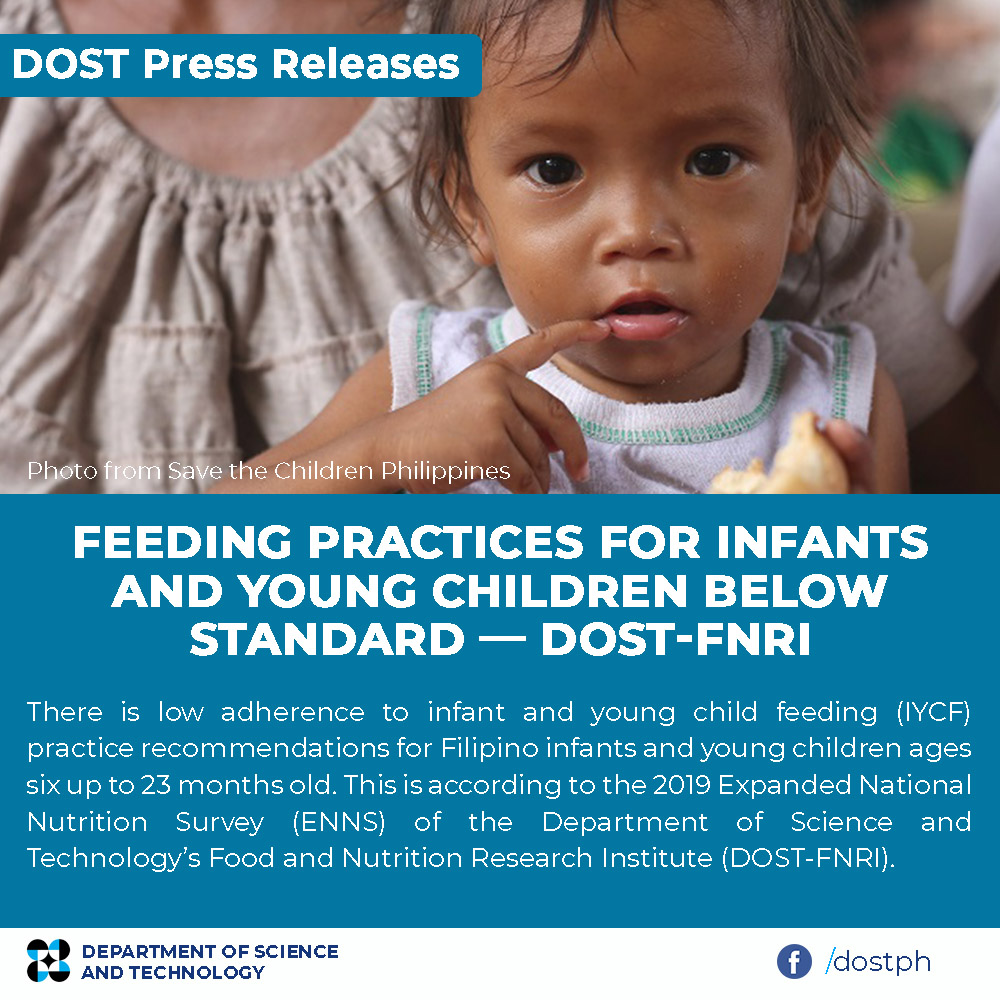Feeding practices for infants and young children below standard — DOST-FNRI

There is low adherence to infant and young child feeding (IYCF) practice recommendations for Filipino infants and young children ages six up to 23 months old.
This is according to the 2019 Expanded National Nutrition Survey (ENNS) of the Department of Science and Technology’s Food and Nutrition Research Institute (DOST-FNRI).
The 2019 ENNS showed that although seven out of 10 Filipino infants and young children age 6-23 months old received timely introduction of complementary foods when they turn six months, eight out of 10 did not meet the minimum dietary diversity.
Minimum dietary diversity (MDD) is a proxy or a “substitute” indicator of micronutrient intake of infants and young children.
The MDD is met when infants and young children age 6-23 months old receive foods from at least four of the following seven food groups: 1) grains, roots and tubers, 2) legumes and nuts, 3) dairy products, 4) flesh meat, 5) eggs, 6) vitamin A rich fruits and vegetables, and 7) other fruits and vegetables.
Moreover, nine out of 10 Filipino infants and young children 6-23 months old are not receiving appropriate complementary feeding, suggesting poor quality and quantity of complementary foods.
In terms of types of complementary foods that most Filipino children 6-23 months old are eating, the 2019 ENNS also showed that five out of 10 eat commercial baby food, while one out of 5 eats lugaw or porridge.
About eight percent (8%) of them consume mashed vegetables, seven percent (7%) boiled rice, four percent (4%) eat biscuits/breads, and two percent (2%) eat fruits, the ENNS further revealed.
At six months old, complementary foods, together with continued breastfeeding, are needed to meet increasing nutritional requirements for proper growth and development of an infant. Complementary foods are meant to “complement” breastmilk in giving the nutrients that babies need.
Complementary foods given to infants and young children ages six to 23 months old should be soft, mashed, well-cooked and prepared safely.
In addition, these foods should be given in gradually increasing consistency, texture and density until young children transition to food from the family pot or regular meals.
Between 6-35 months, children undergo rapid growth and are more susceptible to malnutrition and infections.
The World Health Organization (WHO) declared this stage as the "window of opportunity" or the First 1,000 Days when nutrition-specific and nutrition sensitive interventions should be properly implemented and coordinated across sectors.
Lack of proper and adequate nutrition during this stage may result to stunting, or low length or height-for-age.
Stunting results to impaired growth and development that infants and children experience due to suboptimal breastfeeding and complementary feeding practices, improper nutrition, and environmental hygiene.
It has long-term effects, such as diminished cognitive and physical development, reduced productive capacity, and poor health.
Moreover, intelligence scores of children after the age of three years can no longer be significantly improved even with a better diet.
To address these concerns, the DOST-FNRI Malnutrition Reduction Program (MRP) is implemented. It is an integrated intervention strategy involving nutrition education and technology transfer of complementary food technologies of the Institute.
The MRP is being implemented in collaboration with the DOST regional and provincial offices, local government units (LGUs), entrepreneurs, academe and other organizations involved in nutrition programs.
Moreover, the DOST-FNRI developed complementary food blends and snack foods, and through technology transfer, qualified beneficiaries are provided production equipment and license to produce and commercialize these products in their respective communities.
Aside from the establishment of complementary food processing facilities (CFPFs), the Package for the Improvement of Nutrition of Young Children (DOST-PINOY) will also be implemented in these areas.
The DOST-PINOY provides nutrition education among identified Barangay Health Workers (BHWs) and Barangay Nutrition Scholars (BNSs) on basic nutrition, breastfeeding, complementary feeding, meal planning, safe food handling and preparation, and backyard vegetable gardening.
These trainings and seminars help in enhancing their knowledge and skills to effectively and efficiently implement the program in their localities.
Furthermore, the 2021 Menu Guide Calendar (MGC) of DOST-FNRI focuses on recipes for complementary feeding of 6-23 months old infants and young children to support their optimum growth and development.
The 2021 MGC features innovative kitchen-tested recipes that are sensory acceptable, utilizes locally-available raw materials, and provide adequate nutrient requirements for children 6-23 months old.
The 2021 MGC is available online and may be accessed through: http://bit.ly/2021MGC.
The establishment of complementary feeding plant facilities or CFPFs, conduct of DOST-PINOY, and the development of IEC materials are only some of DOST-FNRI’s science-based intervention programs geared at helping combat malnutrition that persistently plagues children and other population groups all over the country.

